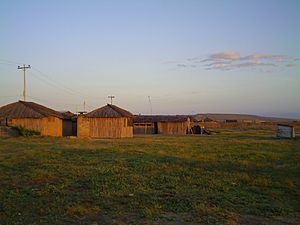Ranchería facts for kids
A ranchería (pronounced ran-cheh-REE-ah) is a Spanish word for a small village or settlement in the countryside. In the Americas, this term was often used for Native American villages or groups of homes. People in the United States also started using the word. They used it to describe the living areas on a large farm, called a rancho, in the American Southwest. These areas housed Native American farm workers and their families. Today, the word is still used in some parts of Spanish-speaking America. For example, the Wayuu people in northern Colombia call their villages rancherías.
The Columbia Encyclopedia describes rancherías as a type of community. These settlements were common for groups like the Yaqui people in Mexico and various Native American groups in the Southwestern U.S., especially in California. Rancherías were more permanent than temporary camps but less permanent than larger pueblo villages. The word could also describe settlements of the California Mission Indians that were outside the Spanish missions.
History of Rancherías in California
In California, the term ranchería refers to 59 Native American settlements. The United States government created 54 of these between 1906 and 1934. They were made for the Native American people who survived and needed places to live.
San Diego State University has a helpful guide called California Indians and Their Reservations: An Online Dictionary. It explains that rancherías were a special part of California's history. A small piece of land was set aside around a Native American settlement to create a ranchería. Some rancherías grew from small groups of Native Americans. These groups formed on the edges of American towns, often to avoid being moved to larger reservations.
Later, in the 1950s, a law changed how the U.S. government worked with Native American tribes. This law meant that about 40 rancherías lost their special federal protection. Their lands were no longer protected by the government, and they lost access to certain federal programs. However, in 1983, a legal case helped 17 rancherías get their federal recognition back. Other rancherías are still working to get their status restored.
How the Word Spread
The word ranchería traveled north during the California Gold Rush. It changed a bit and became "rancherie" in places like the Fraser Canyon Gold Rush in Canada. In British Columbia, Canada, "rancherie" is still used, especially in rural areas. It often means the living area of an Indian reserve, particularly the older parts.
The term was also used for other non-white communities. For example, the Kanaka Rancherie in early Vancouver, British Columbia, was home to Kanaka (Hawaiian) residents. In a shorter form, "the Ranche" was used to describe the Tlingit part of Sitka, Alaska.
See also
 In Spanish: Ranchería para niños
In Spanish: Ranchería para niños


